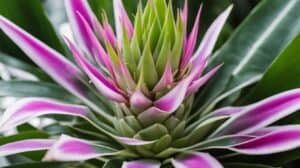The Zebra Plant, also known as Aphelandra squarrosa, is a beautiful and striking plant that is perfect for beginners.
With its bold and unique patterns, it is sure to add a touch of elegance and charm to any space.
This tropical plant is native to Central and South America and is a popular choice for indoor gardening.

One of the most notable features of the Zebra Plant is its striking foliage.
The leaves are dark green with white veins that resemble the stripes of a zebra, hence the name.
The plant can grow up to 2 feet tall and is a popular choice for adding a touch of exoticism to any space.
It is easy to care for and can thrive in a variety of conditions, making it a great choice for beginners who are just starting out with indoor gardening.
Overall, the Zebra Plant is a great choice for those who are looking for a low-maintenance and visually stunning houseplant.
With its unique patterns and easy care requirements, it is sure to be a favorite among beginners and experienced gardeners alike.
Getting to Know the Zebra Plant

The Zebra Plant, also known as Aphelandra squarrosa, is a striking houseplant that is popular among beginners due to its ease of care.
This plant is native to the rainforests of Brazil, and it is admired for its beautiful, glossy leaves that have bold, white stripes resembling zebra stripes.
Origin and Botanical Background
The Zebra Plant belongs to the family Acanthaceae, which includes over 4000 species of flowering plants.
It was first discovered in Brazil in the early 1800s and was introduced to Europe in the mid-1800s.
The plant’s scientific name, Aphelandra squarrosa, is derived from the Greek words “aphelos” meaning simple and “andros” meaning male, referring to the plant’s simple male flowers.
Characteristic Features
The Zebra Plant is a tropical plant that thrives in warm, humid environments.
It has large, glossy leaves that can grow up to 8 inches long and 4 inches wide.
The leaves have bold, white stripes that run parallel to the veins, giving the plant its distinctive zebra-like appearance.
The plant can grow up to 24 inches tall and 18 inches wide, making it a great choice for those looking for a medium-sized houseplant.
The Zebra Plant is relatively easy to care for, as it does not require a lot of attention.
It prefers bright, indirect light and should be watered when the top inch of soil is dry.
Overwatering can lead to root rot, so it is important to ensure that the soil is well-drained.
The plant also benefits from regular fertilization during the growing season, which is typically from spring to fall.
In conclusion, the Zebra Plant is a beautiful and easy-to-care-for houseplant that is perfect for beginners.
Its striking appearance and low-maintenance requirements make it a popular choice among plant enthusiasts.
Caring for Your Zebra Plant
Light and Temperature Requirements
The Zebra Plant thrives in bright, indirect light. It’s important to avoid placing it in direct sunlight as it may scorch the leaves.
A north or east-facing window is ideal. The plant also prefers temperatures between 60-75°F (15-24°C). Avoid exposing it to cold drafts or hot, dry air.
Watering and Humidity Needs
The Zebra Plant prefers to be kept consistently moist but not waterlogged. Water it thoroughly when the top inch of soil feels dry to the touch.
It’s important to avoid letting the soil dry out completely as this can cause the leaves to wilt and drop.
The plant also appreciates high humidity levels, so misting the leaves or placing a humidifier nearby can be beneficial.
Soil and Fertilization Tips
The Zebra Plant prefers well-draining soil that is rich in organic matter.
A mixture of potting soil, peat moss, and perlite can provide the perfect growing environment.
Fertilize the plant every 2-3 months during the growing season with a balanced, water-soluble fertilizer.
Pruning and Maintenance
Pruning can help to maintain the Zebra Plant’s shape and promote healthy growth.
Remove any yellow or damaged leaves as soon as possible to prevent the spread of disease.
Regularly pinch back the tips of the stems to encourage bushier growth.
It’s also important to keep an eye out for pests such as mealybugs and spider mites, which can be treated with insecticidal soap or neem oil.
Troubleshooting Common Issues

Dealing with Pests
Zebra plants are susceptible to pests such as spider mites, mealybugs, and scale insects.
If left untreated, these pests can cause discoloration, stunted growth, and even death of the plant.
To prevent and treat pest infestations, regularly inspect your plant for signs of pests and take action immediately if any are found.
To get rid of pests, use a mild insecticidal soap or neem oil spray.
Alternatively, you can wipe the leaves with a damp cloth or cotton swab dipped in rubbing alcohol.
Be sure to follow the instructions on the product label and avoid using harsh chemicals that can harm the plant.
Addressing Leaf Discoloration
Leaf discoloration is a common issue with zebra plants and can be caused by a variety of factors such as overwatering, underwatering, low humidity, or exposure to direct sunlight.
If the leaves are turning yellow, it may be a sign of overwatering. To remedy this, reduce watering frequency and make sure the soil is well-draining.
If the leaves are turning brown or black, it may be a sign of underwatering.
In this case, increase watering frequency and make sure the soil is evenly moist.
If the leaves are curling or wilting, it may be a sign of low humidity. To increase humidity, mist the leaves regularly or place a humidifier near the plant.
If the leaves are getting burnt or turning brown on the edges, it may be a sign of exposure to direct sunlight.
Move the plant to a spot with indirect sunlight or provide shade.
Solutions for Dropping Leaves
Dropping leaves can be a sign of stress or shock to the plant.
This can be caused by sudden changes in temperature, light, or humidity, or by root damage due to overwatering.
To prevent further leaf drop, make sure the plant is in a stable environment with consistent temperature, light, and humidity.
Check the soil moisture and adjust watering frequency as needed.
If root damage is suspected, gently remove the plant from its pot and inspect the roots for rot or damage.
Trim away any damaged roots and repot the plant in fresh soil.
Propagation and Repotting

How to Propagate the Zebra Plant
Propagation of the Zebra Plant is possible through stem cuttings. To do this, cut a stem with at least two leaves and a node.
Remove the bottom leaves and dip the cut end in rooting hormone powder.
Then, plant the stem cutting in a well-draining potting mix, keeping it moist but not waterlogged.
Covering the pot with a plastic bag will help retain moisture and increase humidity.
After a few weeks, new growth should appear, indicating successful propagation.
When and How to Repot
The Zebra Plant prefers to be slightly root-bound, but when the roots start to fill the pot, it’s time to repot.
This typically happens every 1-2 years. Choose a pot that is only slightly larger than the current one and has drainage holes.
Fill the bottom with fresh potting mix and gently remove the plant from its current pot.
Loosen any tangled roots and place the plant in the new pot, filling in the gaps with more potting mix.
Water thoroughly and allow the soil to drain before placing the plant in a bright, indirect light location.
It’s important not to overwater the newly repotted plant, as this can lead to root rot.
Frequently Asked Questions

How do I care for my Zebra Plant to maintain its vibrant foliage?
To maintain the vibrant foliage of your Zebra Plant, it is important to keep the soil moist but not waterlogged.
Avoid letting the soil dry out completely as this can cause the leaves to wilt and drop.
Additionally, keep the plant in a warm and humid environment, with temperatures between 60-75°F (15-24°C) and humidity levels of 50% or higher.
Fertilize the plant every 2-3 weeks during the growing season with a balanced fertilizer to promote healthy growth and vibrant foliage.
What are the ideal lighting conditions for a healthy Aphelandra Squarrosa?
Zebra Plants thrive in bright, indirect light.
Direct sunlight can scorch the leaves, while low light can cause the plant to become leggy and lose its vibrant foliage.
Place the plant near a window that receives bright, indirect light, or use artificial grow lights if natural light is not available.
How often should I water my Zebra Plant for optimal growth?
Water your Zebra Plant when the top inch of soil feels dry to the touch. Avoid overwatering as this can lead to root rot.
Water thoroughly, allowing excess water to drain out of the bottom of the pot.
In the winter months, reduce watering frequency as the plant enters a period of dormancy.
Can you give me tips on repotting a Zebra Plant?
Zebra Plants prefer to be slightly root-bound, so only repot when the plant has outgrown its current container.
Use a well-draining potting mix and choose a pot that is only slightly larger than the current one.
Carefully remove the plant from its current container and gently loosen any tangled roots.
Place the plant in the new container and backfill with fresh potting mix, ensuring that the plant is at the same depth as before.
What are the common pests that affect Zebra Plants and how can I prevent them?
Common pests that affect Zebra Plants include spider mites, mealybugs, and scale insects.
To prevent infestations, regularly inspect your plant for signs of pests and isolate any infected plants to prevent the spread of pests.
Use a gentle insecticidal soap or neem oil to treat any infestations.
Why are the leaves on my Zebra Plant turning yellow, and how can I fix it?
Yellowing leaves can indicate a variety of issues, including overwatering, underwatering, or nutrient deficiencies.
Check the soil moisture level and adjust watering frequency as needed.
Ensure that the plant is receiving adequate light and fertilize regularly with a balanced fertilizer to provide necessary nutrients.
If the issue persists, consider repotting the plant with fresh soil.














